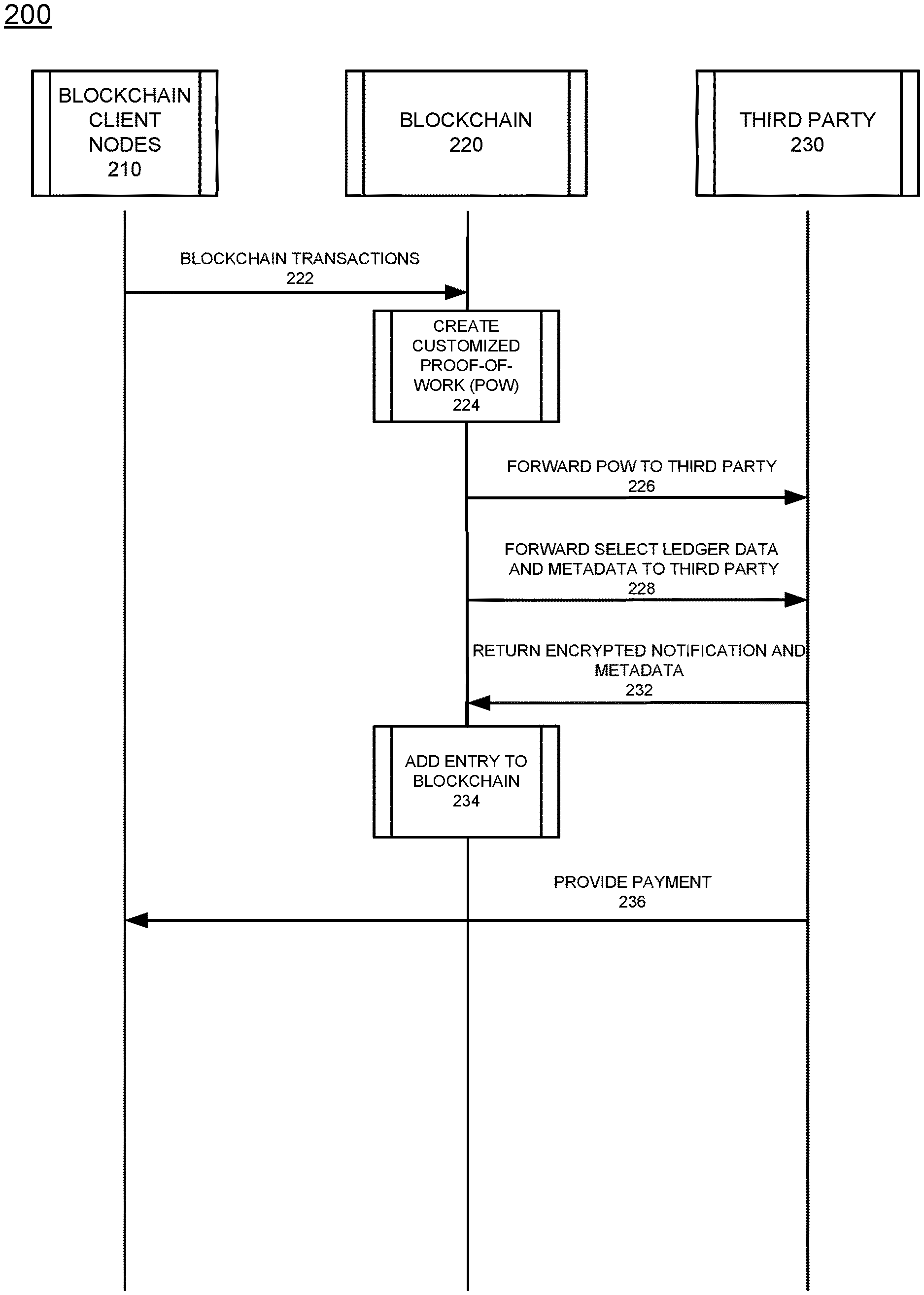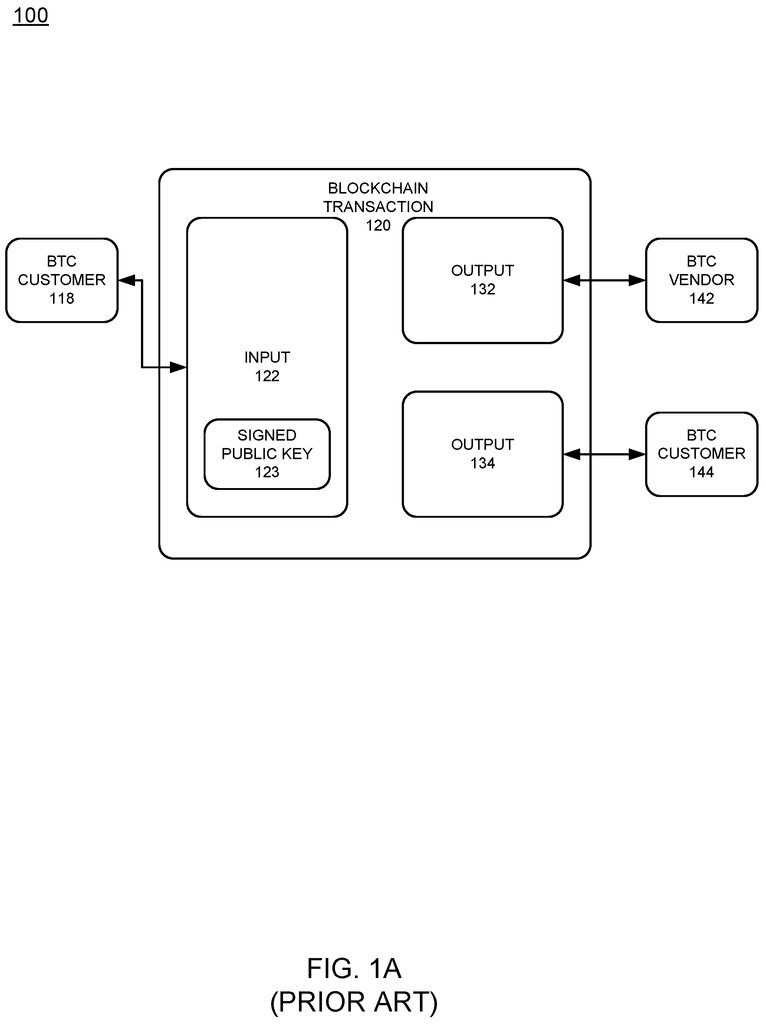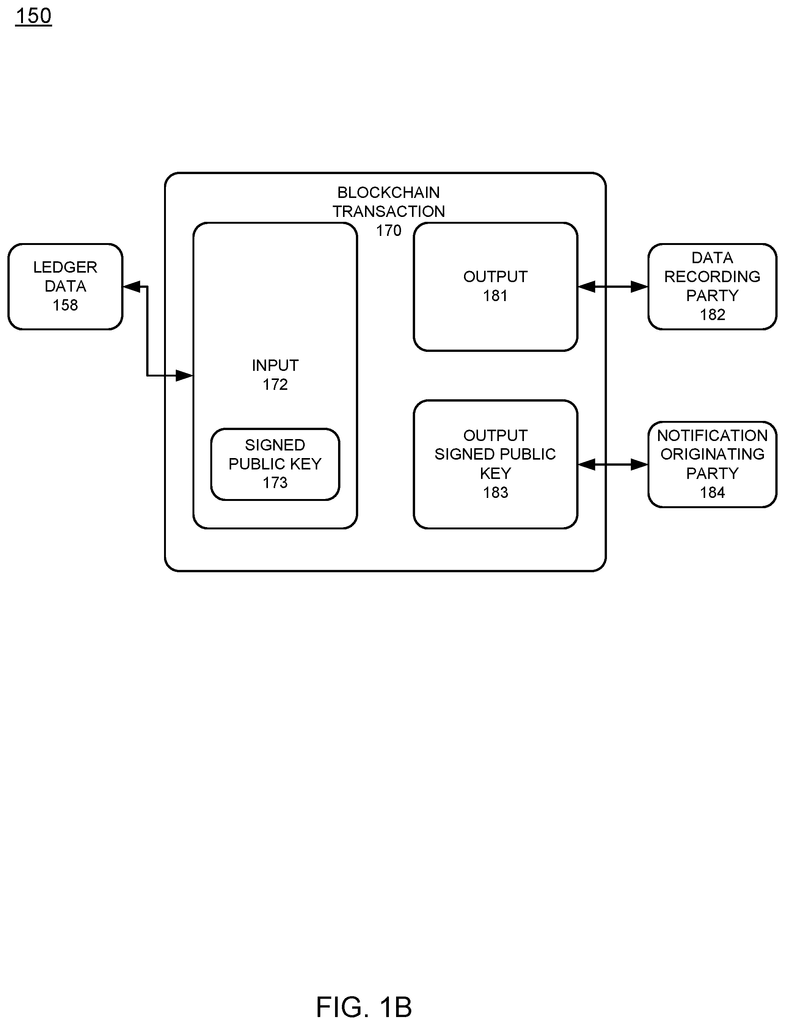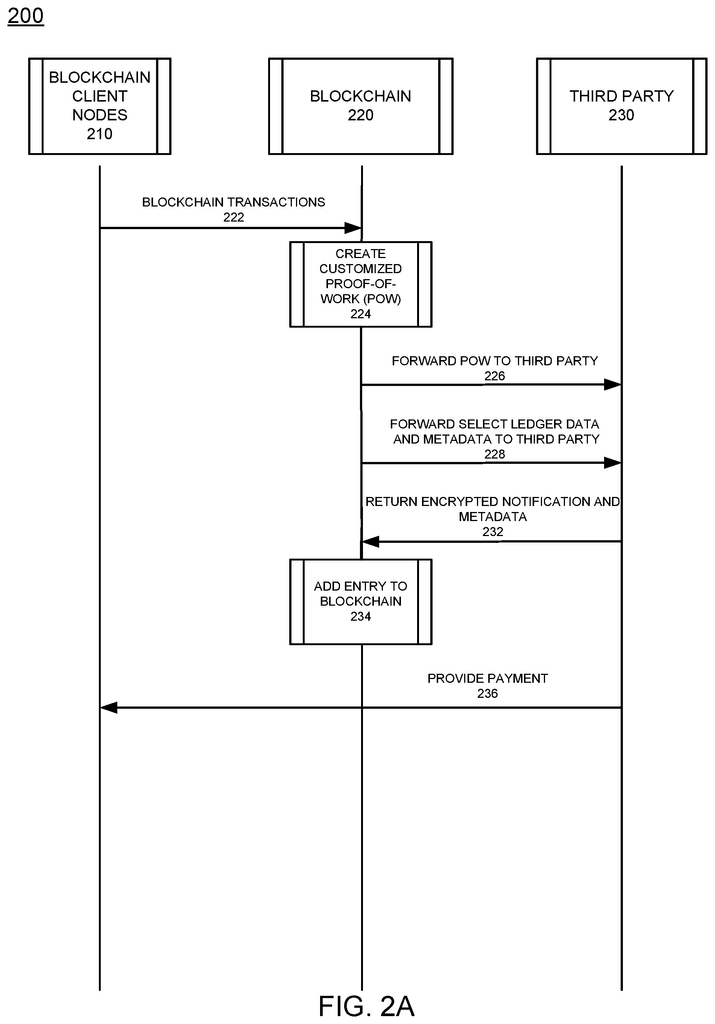Invented by Douglas G. Kinnaird, Ruiping Li, Brian M. O’Connell, Susan K. Schreitmueller, Shelbee D. Smith-Eigenbrode, David D. Weck, Kyndryl Inc
Triggering actions in response to blockchain transactions refers to the ability to automatically execute certain actions or events based on predefined conditions within a blockchain network. This functionality is made possible through the use of smart contracts, which are self-executing contracts with the terms of the agreement directly written into lines of code. Smart contracts can be programmed to automatically trigger specific actions when certain conditions are met.
One of the key applications of triggering actions in response to blockchain transactions is in the field of finance. For example, a smart contract can be programmed to automatically transfer funds from one account to another when a specific condition is met, such as the completion of a certain task or the fulfillment of a contractual obligation. This automation not only saves time and reduces the need for intermediaries but also ensures that transactions are executed accurately and securely.
Supply chain management is another industry that can benefit greatly from triggering actions in response to blockchain transactions. By integrating blockchain technology into supply chain processes, companies can track the movement of goods and trigger actions such as automatic inventory updates, payment settlements, or quality control checks. This automation improves efficiency, reduces errors, and enhances transparency throughout the supply chain.
In the healthcare industry, triggering actions in response to blockchain transactions can have significant implications for patient care and data management. For instance, smart contracts can be used to automatically update patient records, trigger alerts for medication refills, or even initiate emergency responses based on specific health indicators recorded on the blockchain. This automation not only improves the accuracy and timeliness of healthcare processes but also enhances patient safety and outcomes.
The market for triggering actions in response to blockchain transactions is still in its early stages but is expected to grow exponentially in the coming years. As more industries recognize the potential of blockchain technology and its ability to automate actions, the demand for innovative solutions will increase. Startups and established companies alike are already developing and offering products and services in this space, ranging from customizable smart contract platforms to specialized software for specific industries.
However, challenges and considerations need to be addressed as this market evolves. Security and privacy concerns are paramount, as triggering actions in response to blockchain transactions involve the execution of code and the transfer of sensitive information. Additionally, interoperability between different blockchain networks and legacy systems may pose challenges for seamless automation.
In conclusion, the market for triggering actions in response to blockchain transactions is a promising and rapidly growing sector. The ability to automate actions based on predefined conditions within a blockchain network has the potential to revolutionize various industries and improve efficiency, transparency, and security. As the technology matures and more use cases emerge, we can expect to see a surge in innovative solutions and increased adoption of this exciting market.
The Kyndryl Inc invention works as follows
A blockchain can be used to store transactions that are later accessible by interested parties. A method of operation that may be used includes receiving a transaction on the blockchain, identifying the proof of work generated by a network entity for the transaction, sending the proof of work and a selected portion of ledger information to a registered party via an encrypted message using a third-party key, validating and rewarding the proof of-work through the third-party, and providing the reward to the network.
Background for Triggering actions in response to Blockchain transactions
Blockchain relies on a proof-of work scheme to verify the transactions through various nodes in a network. A reward scheme is usually associated with blockchain to reward proof-of work. A miner or verifier can, for example, verify the accuracy of transactions and be rewarded. Incentives are generally paid to the initiator of a transaction when these efforts such as proof-of-work are incentivized.
In blockchain systems known to date, a global ledger can be modified by systems that record transactions based on a proof of work. The first system to solve the puzzle of proof-of-work is awarded a blockchain reward. These rewards can be in the form of transaction fees or additional currency. The transaction fee model can be modified to offer alternative avenues for incentivizing proof-of-work.
One example embodiment provides a method which includes one or more of the following: receiving a Blockchain transaction, identifying that a Proof-of Work is generated for the transaction via a Network Entity, transmitting the Proof-ofwork and a selected portion of ledger information to a registered Third Party via an encrypted message using a Third Party Key, validating proof-of work via the third-party, and providing a rewards to the network entity.
The apparatus may also include a receiver that receives a blockchain transaction and a processor that performs at least one of the following: identify whether a proof of work is generated via a network, transmit the proof of work and a selected portion of ledger information to a registered party via an encrypted message using a third-party key, validate and reward the proof of-work via the third-party.
The example embodiments may also include a nontransitory computer-readable storage medium that is configured to store instructions which, when executed, cause a processor perform any or all of the following: receiving a blockchain transactions, identifying the proof of work generated for the transaction via a networking entity, transmitting a selected portion of ledger information to a registered party via an encrypted message using a third-party key, validating a proof of-work via the registered third-party, and providing a rewards to the network
It will be apparent that the components of the instant invention, as shown in the figures, can be placed in many different ways. The following description of the embodiments, including at least one, of a method and apparatus, non-transitory computing readable medium, and system, as illustrated in the attached figures is not intended limit the scope or claim, but it is representative of select embodiments.
The instant features and structures or characteristics described in this specification can be combined in any way that suits the purposes of one or more embodiments. The usage of phrases like “example embodiments”, “some embodiments”, or similar language throughout this specification indicates that an embodiment could include a specific feature, structure, or characteristic related to the embodiment. The phrases “example embodiments”, “in some embodiments?”, “in other embodiments?”, or any other similar language throughout this specification don’t necessarily refer to the same group. Furthermore, the features, structures, and characteristics described in this specification may be combined in any way that suits the needs of one or more embodiments.
In addition, the term’message’ may be used in the description of embodiments. While the term?message? may have been used to describe embodiments, the application can be applied to any type of network data such as packet, frame, or datagram. The term “message” can also be used. The term “message” can also refer to packet, frame, or datagram. While certain types of signals and messages may be shown in certain embodiments, they are not limited by a particular type of message and the application does not limit itself to that type of signaling.
Example embodiments give third parties the ability to reward systems that validate blockchain transactions using proof-of-work.” The example embodiments also enable new business models such as alerts and notifications based on transactions in the blockchain. The example embodiments offer incentives to proof-of work systems to participate in blockchain systems that are not financial. They also reduce or eliminate costs for initiators of blockchain transaction, and provide the capability to perform targeted advertisements or other notifications while blockchain transactions. Some features of example embodiments reward proof-of work systems by selectively triggering action via exchanged data during blockchain transactions, where the rewards are not from the initiator. Third parties can ‘piggyback’ The third parties may?piggy-back?
By designating a public key of a third-party, a reward could be given to the proof-of work system for sharing a particular ledger entry. A proof-ofwork system allows for the partial or complete transfer of ledger or metadata to a 3rd party, as well as the addition of a notification that will be sent back to the party who initiated the ledger transaction. The third party will know what type of notification they should send. For example, if the notification is for advertising. The notification is signed/encrypted with the public key of the third party so that the original party can verify who created the notification.
By generating a Proof-of Work using selected ledger data/metadata to validate the Proof-ofWork, and sending the data/metadata to the third party system. Thereafter, the third party may return a notification/metadata with an agreement to remit payment once the transaction is added to the blockchain. With the notification, it is possible to amend the ledger entry. The third party does not have to perform the proof of work. However, the third party may be providing payment to the miners performing the proof-of work in exchange for being able to provide notification/advertisements. The metadata can contain information on the blocks, depending on how the blockchain is designed. The blocks can contain information about an item, such as an odometer readout of a car, while the metadata could contain owner information.
FIG. 1A shows a conventional way to perform a blockchain ledger transaction. Referring to FIG. The blockchain transaction process 100 involves modifying the global ledger using nodes who solve proof-of work problems. They then receive a rewards, such as a crypto-currency amount. A customer 118, who can be a BTC customer or BITCOIN client, can pay a certain amount to the input module 122 in a blockchain transaction. The input module 122 can have a public key that is signed 123. The output can include one or multiple outputs. For example, output 132 provides two BTC to a vendor (142) and output 134 provides three BTC to a client (144). FIG. FIG.
FIG. According to an example embodiment, FIG. Referring to FIG. In the approach 150, a modified proof of work system is used to allow a partial transfer or full transfer to a third-party of ledger data and metadata as well as the inclusion of a return notification to the original party of the blockchain transactions 170. In one embodiment, a standard proof-of work is generated by using all the elements of the ledger on the blockchain. However, in another embodiment, a return notification can be sent to the original party. A public key signed by the originating party is created 173 using ledger data 158. The proof-of work is then output 181 along with the selected ledger/meta data to a third party 182. The third party 182 can perform one or more tasks, including: validating the proof-of work, processing the data/meta-data, returning a notification, and agreeing to remit payments once the chain has been added to the Blockchain. The notification can be encrypted using the public key of the originating party 183. “The ledger entry will be updated with the notification sent to the originator 184.
FIG. 2A shows a signaling diagram for a blockchain configuration with a third-party, according to an example embodiment. Referring to FIG. The system 200 consists of a blockchain node(s), a blockchain, and a third-party 230. As blockchain transactions 222 arrive, a proof-of-work 224 can be customized to not notify the original party. The proof-of work may instead identify the third-party 230 who will reward the verifiers of the proof-ofwork. In this example the proof-of work is sent to the third party along with selected ledger data and meta-data 228. The third party validates the proof of work and returns the encrypted notification 232 and metadata to the blockchain 220, along with an agreement that payment will be made once the transaction has been added to the Blockchain. The notification can be encrypted using the public key of the party that sent it. The ledger entry 234 is updated with the notification and payment 236 is made to the blockchain nodes 210. Third parties 230 may then create and/or send a notification to the user device.
FIG. The flow diagram in 2B shows a configuration of a blockchain with a third-party, according to an example embodiment. Referring to FIG. The process 250 is illustrated in FIG. The new entry is validated 254 by solving 256. The ledger data/metadata and proof-of work are encrypted using a key from a third-party that is sent to the third-party 258. If the third-party provides the notification 262, then the block will be amended with the ledger entries and the encrypted notifications 264. The block will be amended with only the ledger entry if the third party does not provide the notification 262. A new blockchain is used to inspect the originating party 268. It is then determined if it contains the notification 273. The notification will be displayed 272, and if it is not, then the process ends.
The instant approach can be enabled by adding a third party public key to the traditional blockchain ledgers. The modifications include one or more: an optional designation for a public key of a 3rd party that will reward the proof-of work system for sharing specific ledger entries, a return of notification instead of a remainder of transaction in a traditional Blockchain system, inserted to the chain at the request by the optional 3rd party, as well as the use of third-party public keys to decrypt notifications.
The instant approach allows for the secure transmission of ledger data or metadata to third parties. The data/metadata can be a part of the entire ledger entry. In one embodiment of the system, data/metadata from a ledger entry is sent to the data recording party or another target party. The originating party will agree to receive some data/metadata in exchange for sending a part or all of a ledger record to a third-party. The notification is an addition to the ledger system and blockchain that allows a third-party to send content to a ledger transaction’s originating party. This notification can be used in a number of ways, including advertising, reminders and notifications, as well as information. Once the ledger entry has been entered into the blockchain, the originating party device may display these notifications.
The instant method can be applied to a service which offers blockchain transactions. In the case of automobile records, for example, ledger entries can be triggered at certain intervals (for instance, every 1000 km), when the vehicle is serviced or when airbags deploy, or when it accelerates quickly. These verified transactions can be used to give interested parties better and more trustworthy resale data for vehicles. Vehicle owners can subscribe to the service to increase the value of the vehicle they want to sell or trade in. Owners may not participate if they are charged per transaction or service. In order to increase participation, third-party advertisement services may offer to pay for the blockchain reward of the originating parties in exchange for providing notifications to the originator. If, for example, an odometer hits a certain value and no service has been recorded in blockchain for a specified number of miles the third party can trigger an advertisement to be sent to the original party for vehicle services or tires, or other targeted advertisements. This type of notification or advertisement is valuable as it is known that the original party requires this service. The originating party may also be incentivized by the third party to receive the service so they can provide a blockchain entry which could increase the value.
FIG. 3A shows a flow chart of an example of a method of operation in accordance with example embodiments. Referring to FIG. The method 300 can include one or more of the following: receiving a blockchain transactions identifying that a proof of work is generated for the transaction via a networking entity 312, sending the proof of work and a selected portion of ledger information to a registered party via an encoded message based upon a key of the third party 314, validating and rewarding the proof of the work via the third-party 316. The reward is determined by a proof of work performed by the network entity. A notification may be sent to the party who initiated the blockchain transaction. The proof-of work omits a return notification to an originating party, and includes a third-party indicator that will forward a selected portion of the blockchain transactions. The method can also include receiving a notification of the selected portion of ledger data, and an indication that payment is to be made for updating the blockchain using the proof-of work. The return notification includes the public key of the party that sent it. This method can also involve amending the ledger in the blockchain to include the return notification.
FIG. The flow diagram 3B shows an example of a method of operation in accordance with example embodiments. This example comprises the following: receiving a transaction on a blockchain identifying that a proof of work is generated by a network entity (352), identifying content related to the transaction (354), determining whether the content is associated with a third party associated with a third party (356), validating the proof of work and the content through the third-party 358 and rewarding the network entity 362. In this example, content from the transaction can be used to identify products or services that may be associated with one or several registered third parties. Content can be matched with a third party who is interested in sponsoring a transaction. The content is used to assign the third party to the transaction. This may be the sponsor of the proof-of work reward for the transaction, and it may also have an advertisement, URL or notification. Include in a return-transaction once the parties involved have been identified.
The above embodiments can be implemented in hardware, in computer programs executed by a processor or in firmware. A computer program can be embedded on a computer-readable medium such as a storage media. A computer program could, for example, reside in random access memory. ), flash memory or read-only memory (??ROM?). ), erasable, programmable read only memory (?EPROM) ), Electrically erasable, programmable read only memory (?EEPROM) Registers, registers, hard drive, a removable disc, a compact disk read only memory (?CDROM?),?EEPROM? ), or any other storage medium that is known to the art.
Click here to view the patent on Google Patents.





